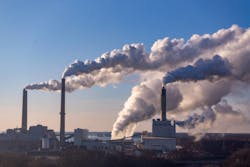Greenhouse Gas Emission Metrics Need Tighter Timeline
Two Stanford University researchers, Sam Abernethy and Robert B Jackson, recently published a paper in Environmental Research Letters, entitled “Global temperature goals should determine the time horizons for greenhouse gas emission metrics”.
In that study, the authors analyzed the emission metrics – defined by the Fifth Assessment Report of the Intergovernmental Panel on Climate Change (IPCC) as “simplified measures of the climate system response to greenhouse gas emissions” – used by the IPCC Special Report on Global Warming of 1.5 °C Scenario Database and the Nationally Determined Contributions (NDCs) of the Paris Agreement. That’s a lot of words to say that they looked at how commitments made under the Paris Agreement should be measured, and they concluded that the most commonly used metric is probably not the best choice.
Emission metrics are intended to provide the means for both government-policy makers and private sector decision-makers to evaluate the relative effects of the various greenhouse gases (GHG). It is these metrics that translate to expressing GHG emissions in terms of CO2-equivalence. Those of us in the HVAC space are at least noddingly familiar with the most common of those metrics, Global Warming Potential (GWP), since it’s a key characteristic in refrigerant regulation.
Emissions metrics use time horizons, and CO2 has relatively long-term effects when compared to GHG with shorter atmospheric lifetimes, which is why its GWP is ‘1’ regardless of the time horizon used. The time horizon selected for GWP in implementing the Paris Agreement was 100 years. GWP measures the radiative forcing of a pulse of GHG compared to the same forcing for a pulse of CO2, integrated over that 100-year time horizon.
Radiative forcing, also defined by the IPCC, is a measure “of the influence a given climatic factor has on the amount of downward-directed radiant energy impinging upon Earth’s surface.” Its most widely criticized limitation is that it measures radiant energy, not temperature. Another metric, Global Temperature (change) Potential (GTP), quantifies the temperature impact of the gas pulses at an established time horizon.
According to the Stanford authors, their concern with using the 100-year time horizon is that it places a greater emphasis on CO2 that remains in the atmosphere for much longer than does short lifetime GHG like methane. Abernethy and Jackson focused on methane because it is a main GHG, second only to CO2, and its atmospheric lifetime is only 11.8 years. They refer to the characterization of the 100-year time horizon, a carryover from the 1997 Kyoto Protocol that took effect in 2005, as “arbitrary and unjustified”.
They concluded that the 100-year time horizon underestimated methane’s GWP and GTP by 34% and 38%, respectively, and recommend that the 100-year time horizon be replaced with a 24-year time horizon, with the year 2045 as the endpoint time. Although the authors did not specifically address it in their paper, according to the U.S. Environmental Protection Agency (EPA), the U.S. also uses the 100-year time horizon as its standard. "Administrator Regan, please check your inbox!"
__________________
A regular contributor to HPAC Engineering and a member of its editorial advisory board, the author is a principal at Sustainable Performance Solutions LLC, a south Florida-based engineering firm focusing on energy and sustainability. He can be reached at [email protected].
About the Author
Larry Clark
A member of HPAC Engineering’s Editorial Advisory Board, Lawrence (Larry) Clark, QCxP, GGP, LEED AP+, is principal of Sustainable Performance Solutions LLC, a South Florida-based engineering firm focused on energy and sustainability consulting. He has more than two dozen published articles on HVAC- and energy-related topics to his credit and frequently lectures on green-building best practices, central-energy-plant optimization, and demand-controlled ventilation.
